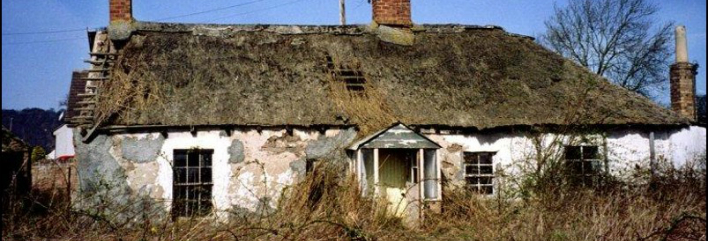A romanticised perception of Scotland’s historic buildings has left traditional earth-built homes - once inhabited by the majority of the population - underappreciated, according to University of Stirling academics.
New research indicates that the severing of links between Scottish people and the landscapes from which they traditionally drew the materials of everyday life has heavily influenced the present-day perception of Scotland’s built heritage. This has placed the focus too heavily on grand structures, rather than the vernacular buildings that were once home to most of the population.

Dr Paul Adderley said that vernacular buildings are often "overlooked".
Experts from the Faculty of Natural Sciences studied the use of earth building materials in Scotland and northern England prior to a period of improvement in the 18th Century. At that time, most people lived in buildings constructed using immediately accessible materials, such as soil, unfired clay and turf.
However, very few of those structures survive today, and academics now fear that this “undervalued” built and cultural heritage is at risk of being lost.
The work was conducted by Dr Paul Adderley and Dr Simon Parkin, of Biological and Environment Sciences, and is published in the international journal Human Ecology.
Dr Adderley said: “Historic earth-built structures are today deeply hidden within the landscapes of Scotland, although they were once a common feature of both urban and rural settlements. Many of these structures were destroyed, repurposed or left to deteriorate following changes to attitudes during the period of Improvement in the 18th Century.
“These buildings are often overlooked as part of Scotland’s heritage and instead many less representative structures– such as castles, cathedrals or crofters’ cottages – are romanticised instead. We suggest that a better understanding of how the majority of people lived in that period can be gained through recognition that they occupied buildings often constructed with earthen components.”
He added: “Our work emphasises the significance of this undervalued aspect of Scotland’s built and cultural heritage, increasingly at risk of being lost completely.”

Dr Simon Parkin said the University of Stirling research will impact the understanding and management of Scotland's built heritage.
Mudwall structures were common in Scottish landscapes for centuries with advances in building practices in the medieval period believed to have contributed to the proliferation of the technique.
The new research is the first major study that has used interdisciplinary approaches to consider the prevalence of such buildings and the reasons why they have been lost from the landscape. The academics used a combination of historical and environmental research methods to develop a set of new understandings: details of the buildings’ construction, their past ubiquity, and the reasons for their disappearance from much of the Scottish landscape.
New insights were obtained through research using forfeited estate papers and other documents discovered in the National Archives of Scotland, as well as details found in the Statistical Accounts of Scotland. Other primary source materials, supplemented by landscape assessments, field studies, and consideration of ever-changing political, economic and environmental contexts were also taken into account.
Dr Simon Parkin added: “Traditional narratives relating to Scotland’s earth-building traditions retain pertinence, but we note here that they must also be accompanied by a greater appreciation of earlier perceptions and definitive proof of past proliferation in order to fully appreciate the significance of these all-but-lost craft traditions.
“Our research will impact the understanding and management of Scotland’s built heritage, which is vital for cultural identity and tourism.”
The study was undertaken as part of a jointly-funded project between Historic Environment Scotland and the University of Stirling.
Background information
Media enquiries to Greg Christison, Communications Officer, on 01786 466 687 or greg.christison@stir.ac.uk

